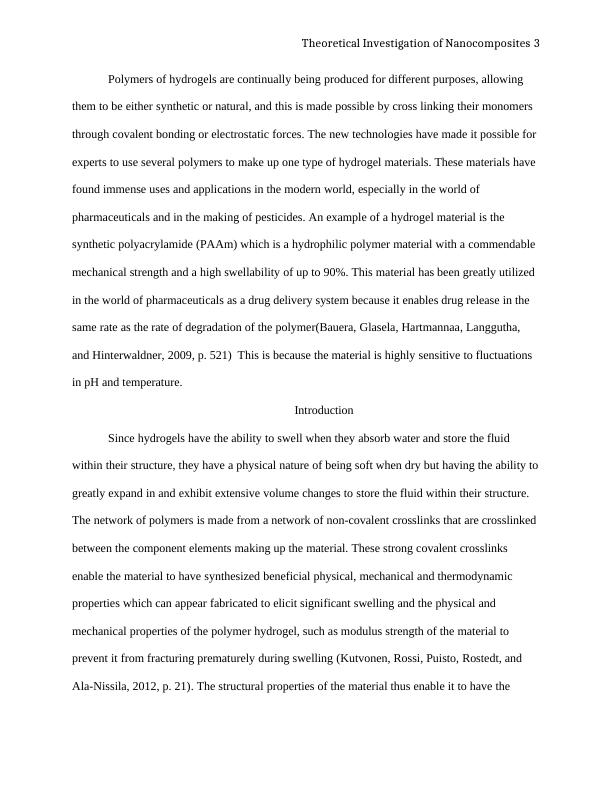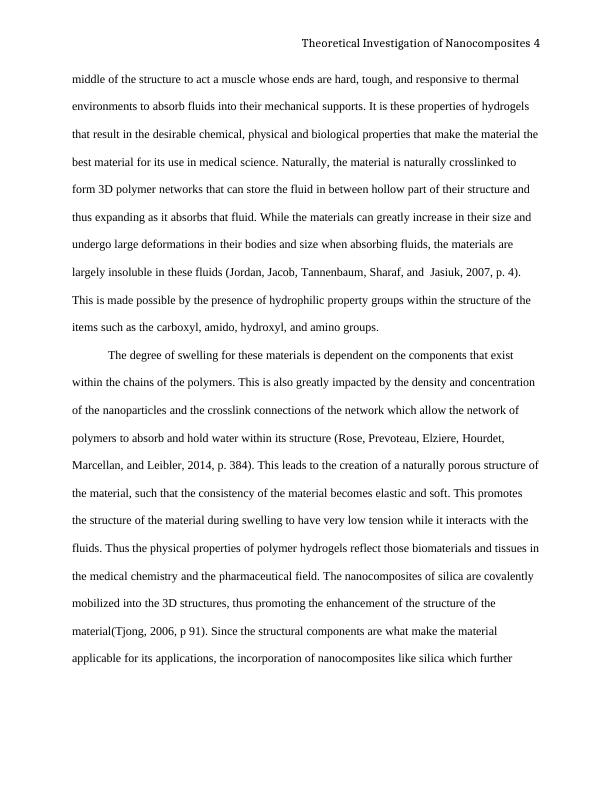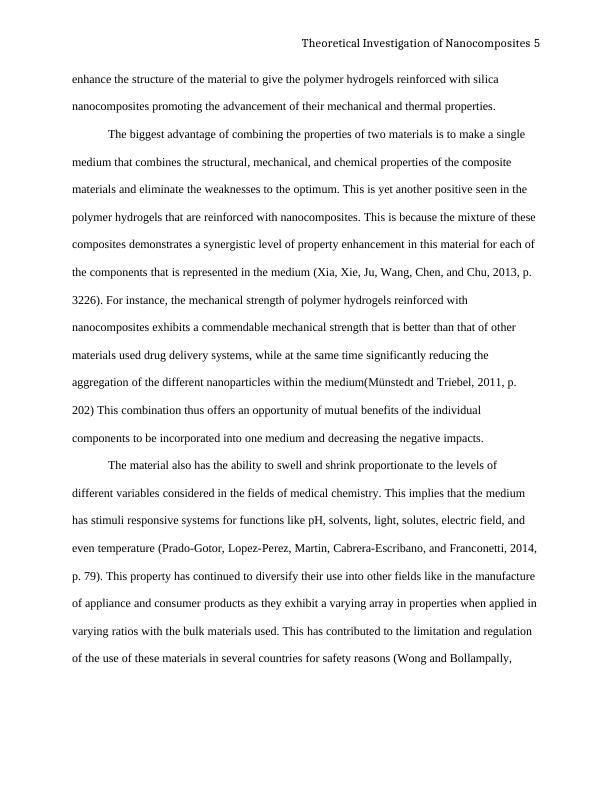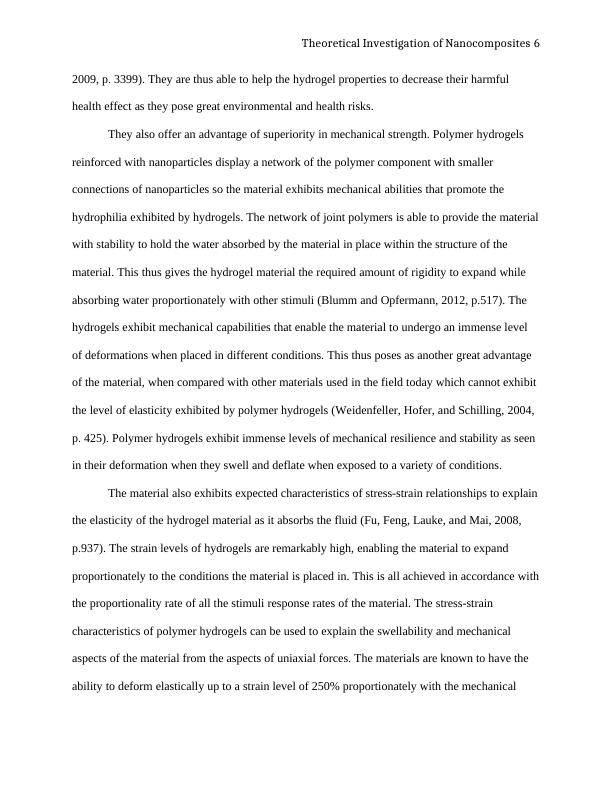Theoretical Investigation of Nanocomposites- Report
36 Pages8875 Words256 Views
Added on 2019-11-26
Theoretical Investigation of Nanocomposites- Report
Added on 2019-11-26
ShareRelated Documents
Theoretical Investigation of Nanocomposites 1Theoretical Investigation of NanocompositesAuthorProfessor UniversityCity, StateDate

Theoretical Investigation of Nanocomposites 2Theoretical Investigation of NanocompositesAbstractNew technologies in materials science and engineering continue to be made possible by the development of new materials, through innovation in combining materials different components whose properties are already known. Hydrogels refer to gel materials with the capacity to absorb large quantities of water, as they are composed of networks of polymeric materials with an abundance of polar groups in polar groups to form 3D structures that are not deformed. These characteristics give hydrogels their hydrophilic nature that leads to their ability to absorb water, while they remain insoluble. A polymer hydrogel can be made by combining the hydrogel properties with nanoparticles like metals, metal oxides, non-metals, and other materials like polymeric moieties. The polymeric hydrogel structural network formed between these polymeric hydrogels and nanoparticles is so well combined that the material has a superiority of functionality to the other materials used for the same applications. The supreme functionality is derived from the material having an increased advantage of mechanical capabilities that allow the material to swell and deswell. The material also has a super advantage of increased sensitivity to stimuli response systems to a variety of environments including pH, solvents, light, solutes, electric field, and even temperature. A close analysis into the stimuli response of temperature and different aspects related to the differences in thermal environment has led to the conclusion that the material exhibits interesting inferences regarding the thermal properties of polymer hydrogels reinforces with nanocomposites(Vashist, Gupta, and Ahmad, 2014, p. 147). These materials are thus used in different fields in medical chemistry, such as drug delivery, catalysts and nano-medicine.

Theoretical Investigation of Nanocomposites 3Polymers of hydrogels are continually being produced for different purposes, allowing them to be either synthetic or natural, and this is made possible by cross linking their monomers through covalent bonding or electrostatic forces. The new technologies have made it possible for experts to use several polymers to make up one type of hydrogel materials. These materials have found immense uses and applications in the modern world, especially in the world of pharmaceuticals and in the making of pesticides. An example of a hydrogel material is the synthetic polyacrylamide (PAAm) which is a hydrophilic polymer material with a commendable mechanical strength and a high swellability of up to 90%. This material has been greatly utilized in the world of pharmaceuticals as a drug delivery system because it enables drug release in the same rate as the rate of degradation of the polymer(Bauera, Glasela, Hartmannaa, Langgutha, and Hinterwaldner, 2009, p. 521) This is because the material is highly sensitive to fluctuations in pH and temperature. IntroductionSince hydrogels have the ability to swell when they absorb water and store the fluid within their structure, they have a physical nature of being soft when dry but having the ability togreatly expand in and exhibit extensive volume changes to store the fluid within their structure. The network of polymers is made from a network of non-covalent crosslinks that are crosslinked between the component elements making up the material. These strong covalent crosslinks enable the material to have synthesized beneficial physical, mechanical and thermodynamic properties which can appear fabricated to elicit significant swelling and the physical and mechanical properties of the polymer hydrogel, such as modulus strength of the material to prevent it from fracturing prematurely during swelling (Kutvonen, Rossi, Puisto, Rostedt, and Ala-Nissila, 2012, p. 21). The structural properties of the material thus enable it to have the

Theoretical Investigation of Nanocomposites 4middle of the structure to act a muscle whose ends are hard, tough, and responsive to thermal environments to absorb fluids into their mechanical supports. It is these properties of hydrogels that result in the desirable chemical, physical and biological properties that make the material thebest material for its use in medical science. Naturally, the material is naturally crosslinked to form 3D polymer networks that can store the fluid in between hollow part of their structure and thus expanding as it absorbs that fluid. While the materials can greatly increase in their size and undergo large deformations in their bodies and size when absorbing fluids, the materials are largely insoluble in these fluids (Jordan, Jacob, Tannenbaum, Sharaf, and Jasiuk, 2007, p. 4). This is made possible by the presence of hydrophilic property groups within the structure of the items such as the carboxyl, amido, hydroxyl, and amino groups. The degree of swelling for these materials is dependent on the components that exist within the chains of the polymers. This is also greatly impacted by the density and concentration of the nanoparticles and the crosslink connections of the network which allow the network of polymers to absorb and hold water within its structure (Rose, Prevoteau, Elziere, Hourdet, Marcellan, and Leibler, 2014, p. 384). This leads to the creation of a naturally porous structure ofthe material, such that the consistency of the material becomes elastic and soft. This promotes the structure of the material during swelling to have very low tension while it interacts with the fluids. Thus the physical properties of polymer hydrogels reflect those biomaterials and tissues inthe medical chemistry and the pharmaceutical field. The nanocomposites of silica are covalently mobilized into the 3D structures, thus promoting the enhancement of the structure of the material(Tjong, 2006, p 91). Since the structural components are what make the material applicable for its applications, the incorporation of nanocomposites like silica which further

Theoretical Investigation of Nanocomposites 5enhance the structure of the material to give the polymer hydrogels reinforced with silica nanocomposites promoting the advancement of their mechanical and thermal properties. The biggest advantage of combining the properties of two materials is to make a single medium that combines the structural, mechanical, and chemical properties of the composite materials and eliminate the weaknesses to the optimum. This is yet another positive seen in the polymer hydrogels that are reinforced with nanocomposites. This is because the mixture of these composites demonstrates a synergistic level of property enhancement in this material for each of the components that is represented in the medium (Xia, Xie, Ju, Wang, Chen, and Chu, 2013, p. 3226). For instance, the mechanical strength of polymer hydrogels reinforced with nanocomposites exhibits a commendable mechanical strength that is better than that of other materials used drug delivery systems, while at the same time significantly reducing the aggregation of the different nanoparticles within the medium(Münstedt and Triebel, 2011, p. 202) This combination thus offers an opportunity of mutual benefits of the individual components to be incorporated into one medium and decreasing the negative impacts. The material also has the ability to swell and shrink proportionate to the levels of different variables considered in the fields of medical chemistry. This implies that the medium has stimuli responsive systems for functions like pH, solvents, light, solutes, electric field, and even temperature (Prado-Gotor, Lopez-Perez, Martin, Cabrera-Escribano, and Franconetti, 2014,p. 79). This property has continued to diversify their use into other fields like in the manufacture of appliance and consumer products as they exhibit a varying array in properties when applied in varying ratios with the bulk materials used. This has contributed to the limitation and regulation of the use of these materials in several countries for safety reasons (Wong and Bollampally,

Theoretical Investigation of Nanocomposites 62009, p. 3399). They are thus able to help the hydrogel properties to decrease their harmful health effect as they pose great environmental and health risks. They also offer an advantage of superiority in mechanical strength. Polymer hydrogels reinforced with nanoparticles display a network of the polymer component with smaller connections of nanoparticles so the material exhibits mechanical abilities that promote the hydrophilia exhibited by hydrogels. The network of joint polymers is able to provide the materialwith stability to hold the water absorbed by the material in place within the structure of the material. This thus gives the hydrogel material the required amount of rigidity to expand while absorbing water proportionately with other stimuli (Blumm and Opfermann, 2012, p.517). The hydrogels exhibit mechanical capabilities that enable the material to undergo an immense level of deformations when placed in different conditions. This thus poses as another great advantage of the material, when compared with other materials used in the field today which cannot exhibit the level of elasticity exhibited by polymer hydrogels (Weidenfeller, Hofer, and Schilling, 2004, p. 425). Polymer hydrogels exhibit immense levels of mechanical resilience and stability as seen in their deformation when they swell and deflate when exposed to a variety of conditions. The material also exhibits expected characteristics of stress-strain relationships to explainthe elasticity of the hydrogel material as it absorbs the fluid (Fu, Feng, Lauke, and Mai, 2008, p.937). The strain levels of hydrogels are remarkably high, enabling the material to expand proportionately to the conditions the material is placed in. This is all achieved in accordance withthe proportionality rate of all the stimuli response rates of the material. The stress-strain characteristics of polymer hydrogels can be used to explain the swellability and mechanical aspects of the material from the aspects of uniaxial forces. The materials are known to have the ability to deform elastically up to a strain level of 250% proportionately with the mechanical

Theoretical Investigation of Nanocomposites 7environments and conditions exerted on the material (Lee, Park, Kim, Lee, and Yoon, 2006, p. 727) Uniaxial stress conditions signify that the polymer hydrogel materials exhibits a stress strain relationship that is non-linear, such as that exhibited by elastic material like rubber.The advantage of the material of stimuli response specifically to temperature also presents interests in the thermal response of polymer hydrogels reinforced with composites, proving that the merge between the components presents immense opportunities in the thermal properties of these materials. The materials present opportunities for research and development in thermal aspects like thermal mechanical analysis, calorimetry, and thermo-gravimetry as theseaspects provide clarity regarding some important detail characteristics of the material (Song, et al., 2012, p. 17136) These characteristics include the polymorphism, stability and glass transitionabilities of the materials. These properties are important for pharmaceutical purposes since they are properties tested for in stability quality control tests of medical and pharmaceutical products. Giving the polymer hydrogels silica nanocomposites reinforcement as in the case of silicananoparticle- reinforced poly (acrylamide) nanocomposites hydrogel (pAAM)gives the material yet another set of covalent crosslinks within the structure of the material. These extra bonds redefine the structure of the material, giving it more mechanical capabilities to hold fluids within its structure and swell and expand in large proportions. It also enables the material to be sensitiveto different thermal environments to give the material thermal properties that are unique and appropriate for the applications of this material in the industry. The concentration of the nanoparticles within the material medium and the size of the media however affects the properties of the hydrogen and how the material responds to the different environments (Tanaka,Montanari, and Mulhaupt , 2004, p. 777). This is because it alters the distribution of the bonds within the structure of the hydrogen polymers and also the structural arrangement and

Theoretical Investigation of Nanocomposites 8distribution of the polymer network and the nanocomposites within this structure. Since the chemical and thermal properties of the material is attributed to the structural arrangement and positioning of the different elements within the material, the concentration of the different elements impacts the properties of the material. The trend is also similar in the analysis of the specific thermal and mechanical properties necessary for the applications of the material in the industry. This has been clearly demonstrated in properties like the elastic modulus which affects the materials ability to deform elastically, as well as the thermal diffusivity of the material (Wang and Zhu, 2011, p. 1424). Thus the material pAAM material with a few nanoparticles distributed within the structure of the material limits the ability of the materials to swell and deswell as is expected. Due to the effect of the reinforced nanocomposites and the impact of their covalent bondson the structure of composite materials, the rate of elastic deformations experienced by enforces polymer hydrogels than that of neat hydrogels. This phenomenon is an account of the effect of the non-covalent links on the stricter of the network of polymer bonds, restricting them form expanding to the larges possible stretching that their structure can allow them so as to hold the fluid within the structure. The structure thus attempts to expand and swell, although the impact of the strong covalent bonds of the nanoparticles on the bonds of the polymer and thus restrictingexpansion and extension of the material to a controllable state (Lu and Mi, 2005, p. 841). This isyet another great advantage of these materials with regard to the mechanical and thermal properties of the material, as this restriction allows for a proportionate expansion of the material, reducing the non-linearity of the stress and strain relationship of this material. This then tames the unpredictability of the response of the material when in specific environment, allowing the material to be appropriate for the different uses when the properties of reinforced

End of preview
Want to access all the pages? Upload your documents or become a member.
